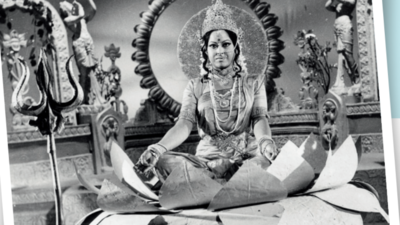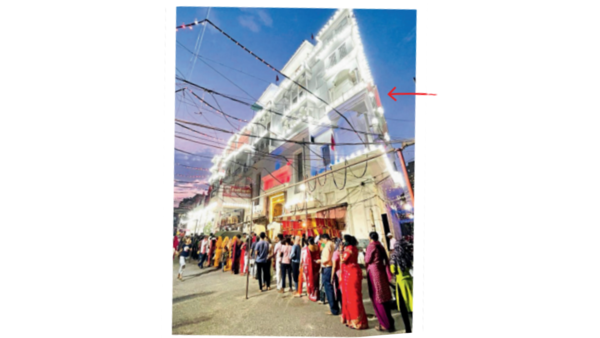When theatres became temples, and a movie became a marvel

In the summer of 1975, filmgoers in Arrah, a small town in central Bihar, would often witness an unlikely spectacle outside their local Sapna cinema. A crowd of eager, chaperoned women — many of them elderly — would arrive in buses, tongas, indeed any vehicle, including the occasional bullock cart, from nearby villages and kasbahs. Most would appear to be first timers at a cinema. Inside the auditorium, many would take off their slippers by the aisle — a few were barefoot anyway — and watch the drama unfold on screen with awe and reverence. It was as if they were attending a satsang, or, a religious congregation. ‘Jai Santoshi Maa’ wasn’t just a devotional movie for them; it was to be a life-influencer.What happened in Arrah was repeated for months in hundreds of tiny towns and puny mofussils across large swathes of India. The film, directed by debutant Vijay Sharma, was released on May 30, four weeks before the draconian Emergency was imposed. Sholay hit the screens on Independence Day. But nothing could stop the march of the frugally budgeted movie where the audience “showered coins, petals and rice at the screen in appreciation”.There’s more. In its 1975 annual report, the Trade Guide rated both ‘Sholay’ and ‘Jai Santoshi Maa’ as blockbusters, ahead of ‘Deewar’ . The movie celebrated jubilee, both gold and silver, in multiple cities. In Arrah, ‘Sholay’ was shown for eight weeks. ‘Jai Santoshi Maa’ ran for 16 weeks, a record for the town. Film Information magazine noted that an extra early morning show was screened at “9am” in Malad, Bombay, to accommodate “the ladies”. Simply put, ‘Jai Santoshi Maa’ was a phenomenon. Even after five years, the film would draw houseful crowds on re-runs.It wasn’t just the cash returns. Since the silent era, devotional movies enjoyed a constant output in Bombay’s cinema bazaar till the 1960s. The convent-educated urban Indian may have scoffed at them, but the genre enjoyed a faithful following among the non-elite. No surprise, the opening credits were written in Hindi, not English, which was the norm. But in the 1970s, the devotional genre took a backseat. Output declined. Barring the modestly successful, ‘Sampoorna Ramayan’ (1973), films flopped. ‘Jai Santoshi Maa’, produced by Satram Rohra, breathed life into the waning genre. The movie’s super success prompted the launch of 30 films starting with “Jai”, wrote Raju Bharatan in a summary of 1975’s Hindi films in The Illustrated Weekly of India. However, few were completed, as subsequent records show.The film’s socio-religious impact has been far more lasting. Australian art historian Michael Brand, who produced a detailed paper on Santoshi Mata booklets in 1982, writes that “it is fairly certain that Santoshi Mata, the Goddess of Contentment, emerged during the 1950s or early 1960s”. It would be equally correct that the movie’s popularity ensured that the little-known goddess, Lord Ganesh’s daughter, was more worshipped than ever before.An impressive Shri Santoshi Mata Mandir, with a white marble floor, is located in West Delhi’s Hari Nagar area . Patron-organiser Amit Saxena says that in the early 1970s, the temple functioned from a small hut. “The large mandir that you see today was built in 1981,” he says.

In 1981, noted anthropologist Veena Das wrote how Santoshi Ma temples proliferated after the movie’s success. Not only were new temples dedicated to Santoshi Ma, but abandoned temples to goddesses like Shitala were also reconsecrated in her name. This, she wrote, happened “not only in metropolitan cities but also in pilgrim cities like Varanasi”.Saxena has an explanation: “After watching the film, many bhakts wanted to visit a Santoshi Mata mandir to express their devotion, to do fasting rituals or just sit there to pay obeisance. That’s why so many mandirs came up at that time.” He further says, “The Goddess of Contentment, Santoshi Mata, tells us not to hanker after worldly possessions. I feel that in today’s materialistic world, this also attracts people.” According to Google Maps, Delhi has at least 30 Santoshi Mata temples now.In his article, art historian Brand writes that the goddess “is mainly, though certainly not exclusively, worshipped by women of the lower middle-income group”. Temple volunteers now say the devotees now belong to every stratum. Outside the Hari Nagar temple, one notices men in swank sedans stop their vehicle, fold their hands and bow their heads before driving away. “Over the years, the temple has been visited by various dignitaries: Dr Manmohan Singh during his finance minister days, Sheila Dixit, Sushma Swaraj, Kiran Bedi and Gen V K Singh,” Saxena says.About 200 devotees visit the temple every day. On Friday, when many of them fast, the number shoots up to roughly 2,000. “The film’s bhajan, ‘Karti hoon tumhara vrat main, sweekar karo ma’ (singer: Usha Mangeshkar), is like an anthem for the worshippers. It is played every Friday,” says Saxena. During Navratras, the mandir is open 24×7, attracting about 10,000 devotees each day.Songs were the highlights of the 1975 movie. Written by Kavi Pradeep, who later received the Dadasaheb Phalke Award, and composed by C Arjun, who delivered the most popular tunes of his career, the tracks became chartbusters. The film’s records were often played on street squares in times when music was largely enjoyed collectively, not individually. ‘Main to aarti utaroon re (singer: Usha Mangeshkar)’ finished third in Binaca Geetmala in 1976.This was a rare film where the youngest of the Mangeshkar sisters got to sing three solos, the climactic ‘Madad karo heyy’ being the third. ‘Yahan waha jahan tahan’, sung separately by both Mahendra Kapoor and Pradeep, also made it to the popular radio show’s charts. “The songs were even heard in Australia on All India Radio’s overseas service,” writes Brand.‘Jai Santoshi Maa’ is plotted around the trials and tribulations of a young couple. Satyawati (Kanan Kaushal) and her husband (Ashish Kumar) are both devotees of the goddess. Satyawati faces a multitude of sorrows, which she overcomes with the blessings of her protector and benefactor.In the movie, she is asked by ‘Devrishi’ Narad — played by Mahipal, the famous actor of mythologicals — to undertake vrat (a ritual that includes fasting) on Fridays. She does so on 16 consecutive Fridays ( solah shukrawar ) and makes the humble offering of gud-chana (jaggery and black gram) to Santoshi Mata.Philip Lutgendorf, professor emeritus of Hindi and Modern Indian Studies, University of Iowa, says that the Friday ‘vrat’ ritual was already becoming popular by word of mouth, but the film dramatically featured and encouraged it. “Making a simple, inexpensive ‘vrat’ the centerpiece of religious practice in the film was a remarkable move on the filmmaker’s part,” says Lutgendorf, who has written extensively on the film.Ajay Kishan, who has a puja items stall near the West Delhi temple, sells at least 50 packs of gud-chana , priced at Rs 10, every Friday. “About 10 temporary stalls come up that day,” he says. Years after the release of ‘Jai Santoshi Maa’, worshippers of the Goddess of Contentment continue to grow. And that includes on the web. The film has been viewed 24 million times on YouTube.DID YOU KNOW?Mahipal, Manher Desai and Trilok Kapoor were major stars in devotionals in the 1950s and 1960s Bharat Bhushan , who won a Filmfare award for his role in ‘Chaitanya Mahaprabhu’, also acted in several socio-religious movies. All four performed as character actors in ‘Jai Santoshi Maa’.





